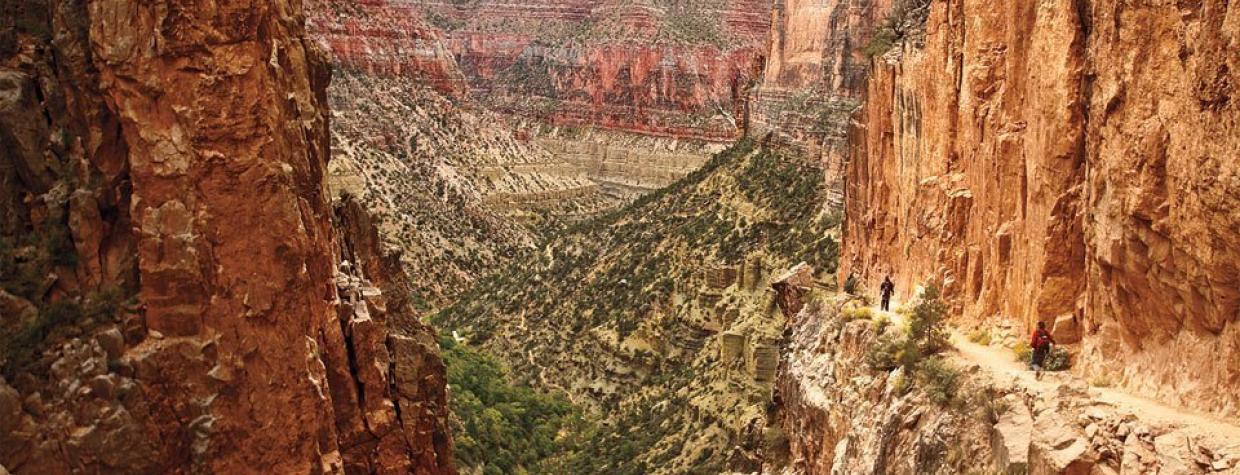Grand Canyon National Park
There are some great hikes on the North Rim, but most of them stay up top and stick to the woods. You’ll get some great views of the Canyon along the way, but those trails won’t take you down. The North Kaibab Trail is the exception. If you really want to experience the Seventh Natural Wonder, and see what it’s like to look up for a change, this is your best option. But before you get started, you need to understand something: Even though this trail winds for 14 miles to Phantom Ranch, the farthest you should ever go on a day hike is to Roaring Springs. It’s a 10-mile round-tripper, and like all Canyon hikes, the trek down is easy, but coming out ... well, the North Kaibab will kill you, but what a way to go.
The trailhead is located a couple of miles north of Grand Canyon Lodge. Unlike its sister trail to the south, the North Kaibab begins with big trees, including Douglas firs, Engelmann spruce and ponderosa pines. You’ll be tempted to look up, but keep your eyes on the trail. Specifically, watch out for the mules and their unpleasant deposits. Mule trains have the right of way in the Canyon, and when you encounter one, step aside and await instructions from the wrangler.
After about 15 minutes of switchbacking, you’ll come to the Coconino Overlook. If you haven’t taken the time to gaze at the wonder before you, now is a good time. What you’re seeing is Roaring Springs Canyon, one of the many side canyons in the Grand Canyon. When you’re hiking back up, but still a few hundred yards below this overlook, you’ll hear the voices of people standing at the overlook. There’s an echo phenomenon that’ll make you think there are people right behind you on the trail, but they’re actually up above.
Heading downhill, you’ll come to a restroom and a water fountain, followed by a 20-foot tunnel. After the tunnel, the switchbacks continue, but the trees are left behind. The makeup of the trail itself changes, too. Above the tunnel, the ground is sandy. Below the tunnel, it starts getting rocky. It’ll stay like that all the way to the bridge, which you’ll cross about an hour into the hike. After the bridge, there’s a rare uphill climb in the Canyon — rare on a downhill hike, that is. The rise takes you to the southwest wall of the canyon, where the trail follows a long ledge with steep drop-offs to your left. It’s along this stretch that you’ll first hear the springs. About 15 minutes later, you’ll catch your first glimpse of the water.
Eventually, about two hours from the trailhead, you’ll come to the mouth of the canyon and an intersection. To the right is the route to Cottonwood Camp and Phantom Ranch. To the left is Roaring Springs, which is 10 minutes away. At this point, you’ll have dropped almost 3,000 feet in elevation. There are some picnic tables and a restroom at Roaring Springs. You should use the facilities, but you should also take off your backpack and enjoy the surroundings. When you’re in Maui, you expect waterfalls like this, but not in the Grand Canyon. It’s spectacular. Drink it in, and remember: You still have 5 miles and 3,000 feet between you and the trailhead.
Length: 10 miles round-trip (to Roaring Springs)
Difficulty: Strenuous
Elevation: 8,225 to 5,221 feet
Trailhead GPS: N 36˚13.020’, W 112˚03.395’
Directions: From the Grand Canyon Lodge on the North Rim, drive north for 2 miles to the signed right turn for the North Kaibab Trailhead.
Vehicle Requirements: None
Dogs Allowed: No
Horses Allowed: No
USGS Maps: Bright Angel Point, Phantom Ranch
Information: Backcountry Office, Grand Canyon National Park, 928-638-7875 or www.nps.gov/grca

